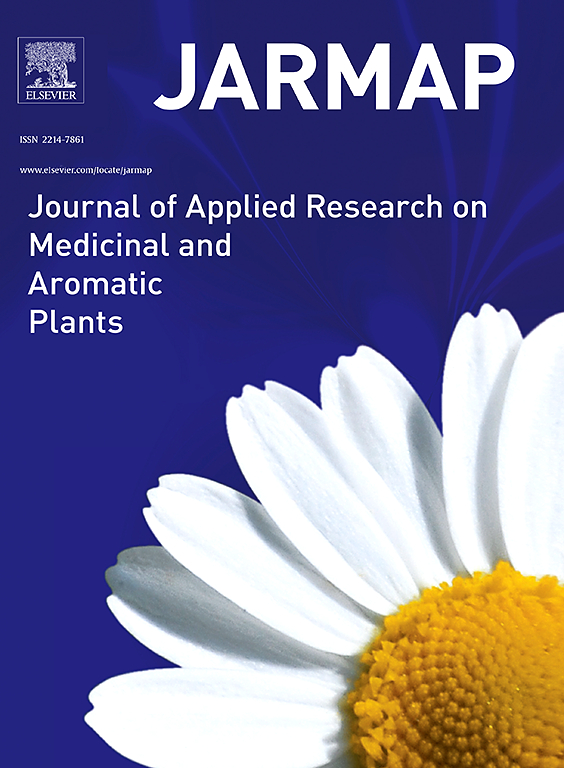Optimization of the extraction of bioactive compounds from the leaves of Campomanesia sessiliflora (O. Berg) Mattos: Standardizing the utilization of a new resource
IF 3.6
2区 农林科学
Q1 PLANT SCIENCES
Journal of Applied Research on Medicinal and Aromatic Plants
Pub Date : 2025-02-01
DOI:10.1016/j.jarmap.2024.100615
引用次数: 0
Abstract
The use of medicinal plants that produce a secondary metabolite continues to grow along with population growth. One of these species is Campomanesia sessiliflora (O. Berg) Mattos. The literature reports that C. sessiliflora is rich in phenolic compounds and flavonoids, which possess high anti-aging activity and can be utilized in the cosmetic and food industries. Optimizing the extraction of bioactive compounds from this plant is crucial for its industrial application. Currently, Campomanesia sessiliflora leaves are discarded as pruning waste. The evaluation of secondary metabolites from C. sessiliflora leaves is essential to making their use feasible for obtaining antioxidant and photoprotective extracts. This study aims to optimize the extraction of phenolic compounds, flavonoids, tannins, chlorophyll α, chlorophyll β, and carotenoids, as well as evaluate the antioxidant potential, sun protection factor (SPF), and the ultraviolet region scans of the leaf extracts. Liquid chromatography with a diode array detector was used to identify chemical compounds. The extracts were evaluated using different plant-to-solvent ratios and varying ethanol concentrations in water. A correlation test was conducted between the spectrophotometric profile and the levels of phenolic compounds, flavonoids, tannins, and the antioxidant potential of C. sessiliflora leaf extracts. Results showed a positive correlation between ethanol levels and the presence of chlorophyll α, chlorophyll β, carotenoids, and flavonoids. Additionally, a correlation was found between antioxidant potential, SPF, and phenolic compound content. Statistical analyses indicate that the ethanol concentration in water is more significantly relevant than the different plant-to-solvent proportions. Gallic acid, syringic acid, catechin, epicatechin, and rutin were identified in all samples. Absorption at the 260 nm wavelength can be used for extract quality control. Regarding the monitored parameters, the best extract was obtained using 2 % leaves in 25 % ethanol in water.
山芋叶中生物活性物质的提取工艺优化:新资源的规范化利用
随着人口的增长,对产生次生代谢物的药用植物的使用也在继续增长。其中一种是Campomanesia sessiliflora (O. Berg) Mattos。文献报道无梗草含有丰富的酚类化合物和黄酮类化合物,具有较高的抗衰老活性,可用于化妆品和食品工业。优化从该植物中提取生物活性化合物的工艺对其工业应用至关重要。目前,无梗木芋叶作为修剪废弃物被丢弃。无梗草叶次生代谢物的评价是确定其抗氧化和光保护提取物的重要依据。本研究旨在优化黄酮类化合物、单宁、叶绿素α、叶绿素β和类胡萝卜素的提取工艺,并对叶提取物的抗氧化能力、防晒系数(SPF)和紫外区扫描进行评价。采用二极管阵列检测器的液相色谱法对化合物进行了鉴定。采用不同的植物与溶剂比和不同的乙醇浓度对提取物进行了评价。采用分光光度法对无梗草叶提取物中酚类化合物、黄酮类化合物、单宁含量及抗氧化活性进行了相关性分析。结果表明,乙醇水平与叶绿素α、叶绿素β、类胡萝卜素和黄酮类化合物的含量呈正相关。此外,还发现抗氧化能力、SPF和酚类化合物含量之间存在相关性。统计分析表明,与不同的植物-溶剂比例相比,水中乙醇浓度的相关性更显著。在所有样品中均鉴定出没食子酸、丁香酸、儿茶素、表儿茶素和芦丁。260 nm吸收波长可用于提取液的质量控制。根据监测参数,以2 %的叶片和25 %的乙醇水溶液为最佳提取液。
本文章由计算机程序翻译,如有差异,请以英文原文为准。
求助全文
约1分钟内获得全文
求助全文
来源期刊

Journal of Applied Research on Medicinal and Aromatic Plants
Pharmacology, Toxicology and Pharmaceutics-Drug Discovery
CiteScore
6.40
自引率
7.70%
发文量
80
审稿时长
41 days
期刊介绍:
JARMAP is a peer reviewed and multidisciplinary communication platform, covering all aspects of the raw material supply chain of medicinal and aromatic plants. JARMAP aims to improve production of tailor made commodities by addressing the various requirements of manufacturers of herbal medicines, herbal teas, seasoning herbs, food and feed supplements and cosmetics. JARMAP covers research on genetic resources, breeding, wild-collection, domestication, propagation, cultivation, phytopathology and plant protection, mechanization, conservation, processing, quality assurance, analytics and economics. JARMAP publishes reviews, original research articles and short communications related to research.
 求助内容:
求助内容: 应助结果提醒方式:
应助结果提醒方式:


